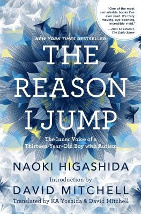The Reason I Jump: The inner voice of a thirteen-year-old boy with autism by Naoki Higashida

Translated by K. A. Yoshida and David Mitchell. Random House, 2013.
ISBN 978081299486.
The introduction to this remarkable book begins, 'The thirteen
year-old author of this book invites you, his reader, to imagine a
daily life in which your faculty of speech is taken away. Explaining
that you're hungry, or tired, or in pain, is now as beyond your
powers as a chat with a friend . . . Now imagine that after you have
lost your ability to communicate, the editor-in-residence who orders
your thoughts, walks away without notice . . . A dam-burst of ideas,
memories, impulses and thoughts is cascading over you, unstoppably.
Your editor controlled this flow, diverting the vast majority away,
and recommending just a tiny number for your conscious
consideration. But now you're on your own. Now your mind is a room
where twenty radios, all tuned to different stations, are blaring
out voices and music. The radios have no off-switches or volume
controls . . . and relief will only come when you're too exhausted
to stay awake.'
On top of that the editor of your senses has also quit and you are
now bombarded by all the sights, sounds, smells, tastes and textures
of the environment without filters so each clamours equally for
attention; your vestibular and proprioceptive senses are disturbed
so the floor keeps tilting and you have no sense of where your hands
are feet are in relation to the rest of you. Your mother tongue is a
foreign language and you have no concept of time.
Such is the life sentence of the person with autism, and it is a
life that we, as teachers, need to have some concept of as more and
more children on the autism spectrum come under our care. Thus, the
importance of this book. In it, Naoki, who is able to use a device
which enables him to communicate via writing, provides some insight
into what it is like to live in an unfiltered world without the
internal connections to make sense of it.
He starts by writing, 'When I was small, I didn't even know that I
was a kid with special needs. How did I find out? By other people
telling me that I was different from everyone else, and that this
was a problem.' And one of the most consistent messages that comes
through his writing is his concern that his needs and inabilities
are a problem for those around him. Written in a question-and-answer
format, this articulate young man tries to explain some of the
behaviours that are associated with autism so we can understand that
they are not based on defiance, malice, or any intentional motive.
Full of quotable quotes, there is an overwhelming sense of isolation
and a desire to please, and a realisation for the reader that the
greatest gift we can give Naoki and all autistic children is our
time and patience. Repeatedly he begs us 'not to give up' on him.
The autistic child's fascination with numbers which are constant is
explained; their need to order and repeat becomes clear and their
connection to nature made obvious. This latter is underpinned by the
most remarkable illustrations - monotone prints which focus on the
natural lines, shapes and patterns that we so often don't appreciate
because we don't even see them. Interspersed are observations and
short stories that Naoki has written - he says he aspires to be a
writer but it is clear he already is.
This book took me about 90 minutes to read; it will take me so much
longer to reflect on and learn from, and it will change my
understanding for ever.
Barbara Braxton